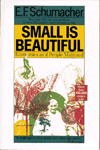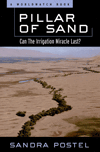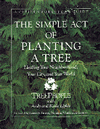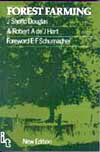
![]()
Search the Journey to Forever website – click HERE
|
Journey to Forever: Make a donation |
Navigation
| Trees, soil and water |
| In the news |
| Not in the news |
| References and resources |
| Trees for deserts: HDRA |
| Trees and forests -- resources for schools |
Contact usTo Keith Addison Handmade Projects |
Trees, soil and water
References and resources
Half the inhabitants of Earth cook over woodfires: nearly half the world's wood supply is used as fuel. But there's not enough of it to go round -- more than 2 billion people now face shortages of fuelwood. See Solar box cookers
The Henry Doubleday Research Association has assisted hundreds of projects in Third World countries, helping to plant millions of drought-resistant trees -- at a cost of less than a penny a tree. See Trees for deserts
"The Rape of the Earth: A World Survey of Soil Erosion", by G.V. Jacks and R.O. Whyte, Faber and Faber, London, 1939.
Don't say we weren't warned. If only we'd listened! "Erosion in Nature is a beneficent process without which the world would have died long ago. The same process, accelerated by human mismanagement, has become one of the most vicious and destructive forces that have ever been released by man." Not just a damnation, it also charts the path to redemption. As relevant today as when it was written. An extraordinary book.
"Tree Crops -- A Permanent Agriculture," by J. Russell Smith, Harcourt-Brace, New York, 1929; Devin-Adair, Connecticut, 1950; Island Press Conservation Classics, 1987, ISBN 0-933289-44-0
Russell Smith was 50 years ahead of his time, writing the basic text on agroforestry long before there was such a thing. He travelled widely and saw it all coming. The best book about trees -- it's inspired generations of environmental activists, including all the leading lights in the movement. Wonderful! Introductory chapters online in the Small Farms Library. Buy the book from Powell's Books:
http://www.powells.com/biblio/61-9780911469196-0
Download the complete book from CD3WD online library (58.8Mb pdf):
http://www.fastonline.org/CD3WD_40/JF/419/08-302.pdf
 "Small Is Beautiful: Economics As If People Mattered", by E. F. Schumacher, HarperCollins, 1973, 1989, ISBN 0060916303, 324 pages. This book has sold 700,000 copies -- no small figure for a book on economics. Required reading for anyone interested in development. If it had sold 7 million copies there'd be a lot less poverty, hunger and environmental degradation in the world than there is now. Buy at Amazon.com: Small Is Beautiful
"Small Is Beautiful: Economics As If People Mattered", by E. F. Schumacher, HarperCollins, 1973, 1989, ISBN 0060916303, 324 pages. This book has sold 700,000 copies -- no small figure for a book on economics. Required reading for anyone interested in development. If it had sold 7 million copies there'd be a lot less poverty, hunger and environmental degradation in the world than there is now. Buy at Amazon.com: Small Is Beautiful
Practical Action (Intermediate Technology Development Group, ITDG), founded by Schumacher in 1966:
http://practicalaction.org/
 "Pillar of Sand: Can the Irrigation Miracle Last?" by Sandra Postel, W.W. Norton & Company, 1999, $13.95, ISBN: 0393319377
"Pillar of Sand: Can the Irrigation Miracle Last?" by Sandra Postel, W.W. Norton & Company, 1999, $13.95, ISBN: 0393319377
Protecting rivers and vital ecosystems as the world aims to feed 8 billion people will require a doubling of water productivity -- getting twice as much benefit from each gallon removed from rivers, lakes, and aquifers. Pillar of Sand points the way toward managing the growing competition for scarce water. And it lays out a strategy for correcting the major flaw of the modern irrigation age: its failure to better the lives of the majority of the world's poorest farmers.
From Worldwatch Institute
http://www.worldwatch.org/pubs/ea/pos.html
"Appropriate Farm Technologies for Cold and Dry Zones of the Hindu Kush-Himalayas", edited by Shaheena Hafeez, International Centre for Integrated Mountain Development (ICIMOD), Kathmandu, Nepal, 1998. 153 pages. ISBN: 92-9115-838-0 Developed countries US$20.00, developing countries US$15.00; ICIMOD regional member countries US$10.00.
From ICIMOD, P.O. Box 3226, Kathmandu, Nepal
Fax: +977 (1) 524509, 536747
Email: distri@icimod.org.np
Over 1,000 tribes live in the highest, most fragile and most populous mountain regions in the world: the Hindu Kush-Himalayan Region (Afghanistan, Bhutan, India, Nepal, Bangladesh, China, Myanmar, and Pakistan). ICIMOD helps to "promote the development of an economically and environmentally sound mountain ecosystem and to improve the living standards of the mountain populations". This book focuses on "appropriate and indigenous farm technologies in selected sites within their respective countries". One chapter focuses on pro-women technologies: "Indigenous agro-based technologies are women-specific and focus on gender-equity in the male-dominated social structures of the HKH region by strengthening the economic empowerment of women." Order online:
http://www.icimod.org.sg/publications/catalogue/mfscatal.htm
"Roots in the African Dust: Sustaining the Sub-Saharan Drylands", by Michael Mortimore, Cambridge University Press, Cambridge, United Kingdom, 1998. 219 pages. ISBN: 0 521 45173 6 (hardback); ISBN: 0 521 45785 8 (paperback) US$59.95 (hardback)
 The image of Africa in the modern world is shaped by perceptions of drylands and poverty, drought, degradation and famine. Mortimore offers an alternative vision, dismissing the conventional view of runaway desertification, driven by population growth and inappropriate land use. He suggests a more optimistic model of sustainable land use which is based on researched case studies from East and West Africa, where indigenous technological adaptation has put population growth and market opportunities to advantage. Order online:
The image of Africa in the modern world is shaped by perceptions of drylands and poverty, drought, degradation and famine. Mortimore offers an alternative vision, dismissing the conventional view of runaway desertification, driven by population growth and inappropriate land use. He suggests a more optimistic model of sustainable land use which is based on researched case studies from East and West Africa, where indigenous technological adaptation has put population growth and market opportunities to advantage. Order online:
http://www.cup.cam.ac.uk/
 "The Simple Act Of Planting A Tree: A Citizen Forester's Guide to Healing Your Neighborhood, Your City, and Your World" TreePeople with Andy and Katie Lipkis, Jeremy P. Tarcher, Inc., Los Angeles, 1990, $12.95, ISBN 0-87477-602-3 (paper).
"The Simple Act Of Planting A Tree: A Citizen Forester's Guide to Healing Your Neighborhood, Your City, and Your World" TreePeople with Andy and Katie Lipkis, Jeremy P. Tarcher, Inc., Los Angeles, 1990, $12.95, ISBN 0-87477-602-3 (paper).
This comprehensive training manual written and used by the urban forestry group Treepeople can be applied far beyond the California territory Treepeople now covers. Much of the information can be used in either tropical or temperate zones. The step-by-step Planting Project Workbook and the Tree Care Project Workbook contain specific notes that guide you through your project. "This book is dedicated to Citizen Foresters everywhere. May we reforest the earth!"
From TreeLink, the community forestry resource:
http://treelink.org/books/simpleact/index.htm
Also: What Tree Is That? -- an online guide to the more common trees found in the Eastern and Central US, courtesy of The National Arbor Day Foundation. Useful guide, step-by-step, yes-or-no, with illustrations.
http://treelink.org/whattree/
 "Forest Farming: Towards a solution to problems of world hunger and conservation" by J. Sholto Douglas & Robert de J. Hart, Rodale Press, 1978, Intermediate Technology Publications, 1984, ISBN 0946688303
"Forest Farming: Towards a solution to problems of world hunger and conservation" by J. Sholto Douglas & Robert de J. Hart, Rodale Press, 1978, Intermediate Technology Publications, 1984, ISBN 0946688303
The integration of tree and other farming establishes a sounder ecological balance and greater productivity of food and materials for clothing, fuel and shelter. Only 8-10% of the world's surface is currently used for food production, but planting of crop-yielding trees could raise that figure to 75%. The book suggests planting and cropping methods and a range of potentially useful trees. Foreword by Fritz Schumacher ("Small is Beautiful"). From the Development Bookshop:
http://developmentbookshop.com/product_info.
php?manufacturers_id=&products_id=30
Download complete book from CD3WD online library (22Mb pdf):
http://www.fastonline.org/CD3WD_40/JF/419/08-307.pdf
New Crop Resource -- the Center for New Crops & Plant Products, at Purdue University, a vast database -- or group of databases -- of information on plants and trees both new and old. CropSEARCH, CropINDEX, CropREFERENCE -- Books and manuals; also Aromatic-MedicinalPLANTS, Famine Foods -- unconventional food sources, links.
http://www.hort.purdue.edu/newcrop/
Paper facts
A Paperless Office? Reams Pile Up Despite Computers
Wall Street Journal, May 28, 1999: When it comes to one of high tech's earliest promises -- to shrink the amount of paper weighing us down -- the industry gets a flunking grade. Each year, businesses world-wide use 4% to 7% MORE paper -- a pace that puts them on track to almost double their consumption each decade. And computing applications are clearly to blame. Introduce email to an office and the amount of printing soars 40%, according to one study.
Paper Facts, from Rethink Paper -- highly recommended website. Vision, information, action.
http://www.rethinkpaper.org/
- What is the global per capita consumption of paper? -- 108 lbs.
- How many newspapers do Americans buy a day? -- 62 million
- How many tons of professional printing and writing papers are produced annually in the US? -- 26.6 million tons
- What sector of the paper market is growing the fastest? -- Professional production and communication papers, having increased over 4 million tons in total volume between 1991 and 1997.
- How much paper does the United States consume per capita in one year? -- 735 lbs/person
- How many sheets of paper does the average person use in one year? -- 200,000 sheets
- By what percentage is global pulp and paper consumption projected to increase? -- According to the FAO by 100% by 2010
- How many sheets of paper are in one pound? -- 300 sheets
- Total amount of total wood pulp consumed in the US per ton/year? -- 64.1 million tons
- What is the average pulp and paper industry consumption of wood per year? -- 9.1 billion cubic feet
- What percentage of the original forests are remaining in the US? -- 5%
- What percentage of original global forests are remaining? -- 54%
Trees, soil and water
In the news
Not in the news
References and resources
Trees for deserts: HDRA
Trees and forests -- resources for schools
See:
Farming with trees